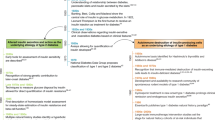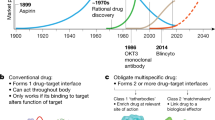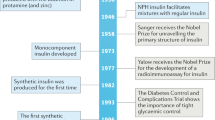Abstract
Born 20 years ago with the launch of recombinant insulin, the biotechnology industry is maturing, with several leading companies now rivalling traditional pharmaceutical companies in many ways. What might the next 20 years hold for biotech-based drug development?
This is a preview of subscription content, access via your institution
Access options
Subscribe to this journal
Receive 12 print issues and online access
$209.00 per year
only $17.42 per issue
Buy this article
- Purchase on Springer Link
- Instant access to full article PDF
Prices may be subject to local taxes which are calculated during checkout



Similar content being viewed by others
References
Berg, C., Nassr, R. & Pang, K. The evolution of biotech. Nature Rev. Drug Discov. 1, 845–846 (2002).
Decision Resources, Inc., Biotech Alliances 2001: Feeding and Riding the Tiger (Decision Resources, Inc. Spectrum, Pharmaceutical Industry Dynamics, Issue 6, 22 May 2002).
Decision Resources, Inc., Outlook for the European Biotechnology Industry: Industry and Government Cooperation Key to Continued Growth (Decision Resources, Inc. Spectrum, Pharmaceutical Industry Dynamics, Issue 9, 26 June 2002).
Lindpaintner, K. The impact of pharmacogenetics and pharmacogenomics on drug discovery. Nature Rev. Drug Discov. 1, 463–469 (2002).
Roses, A. D. Genome-based pharmacogenetics and the pharmaceutical industry. Nature Rev. Drug Discov. 1, 541–549 (2002).
Lesko, L. J. & Woodcock, J. Pharmacogenomic-guided drug development: regulatory perspective. Pharmacogenomics J. 2, 20–24 (2002).
Roses, A. D. Apolipoprotein E alleles as risk factors in Alzheimer's disease. Annu. Rev. Med. 47, 387–400 (1996).
Farrer, L. A. et al. Effects of age, sex, and ethnicity on the association between apolipoprotein E genotype and Alzheimer disease. A meta-analysis. APOE and Alzheimer Disease Meta Analysis Consortium. JAMA 278, 1349–1356 (1997).
Tang, M. X. et al. The APOE4 allele and the risk of Alzheimer disease among African Americans, whites, and Hispanics. JAMA 279, 751–755 (1998).
Kardaun, J. W. et al. Genotypes and phenotypes for apolipoprotein E and Alzheimer disease in the Honolulu-Asia aging study. Clin. Chem. 46, 1548–1554 (2000).
Graff-Radford, N. R. et al. Association between apolipoprotein E genotype and Alzheimer disease in African American subjects. Arch. Neurol. 59, 594–600 (2002).
Lai, E., Riley, J., Purvis, I. & Roses, A. D. A 4-Mb high-density single nucleotide polymorphism-based map around human APOE. Genomics 54, 31–38 (1998).
Hewett, D. et al. Identification of a psoriasis susceptibility candidate gene by linkage disequilibrium mapping with a localized single nucleotide polymorphism map. Genomics 79, 305–314 (2002).
McCarthy, L. C. et al. Single-nucleotide polymorphism alleles in the insulin receptor gene are associated with typical migraine. Genomics 78, 135–149 (2001).
Burbaum, J. & Tobal, G. M. Proteomics in drug discovery. Curr. Opin. Chem. Biol. 6, 427–433 (2002).
Petricoin, E. F., Zoon, K. C., Kohn, E. C., Barrett, J. C. & Liotta, L. A. Clinical proteomics: translating benchside promise into bedside reality. Nature Rev. Drug Discov. 1, 683–695 (2002).
Lovell-Badge, R. The future for stem cell research. Nature 414, 88–91 (2001)
Bianco, P. & Gehron Robey, P. Stem cells in tissue engineering. Nature 414, 118–121 (2001).
United Nations. World population prospects, The 1998 Revision (United Nations, Department of Economic and Social Affairs Population Division, United Nations, New York, 1999).
Organization for Economic Cooperation and Development Health Data (2002) [online] (cited 27 Nov 2002) <http://www.oecd.org/EN/statistics/0,,EN-statistics-12-nodirectorate-no-1-no-12-no-no-2,00.html>.
World Factbook 2001 Publisher (Central Intelligence Agency, Washington DC, USA).
Author information
Authors and Affiliations
Corresponding author
Related links
Related links
DATABASES
Cancer.gov
LocusLink
OMIM
FURTHER INFORMATION
Rights and permissions
About this article
Cite this article
Nagle, T., Berg, C., Nassr, R. et al. The further evolution of biotech. Nat Rev Drug Discov 2, 75–79 (2003). https://doi.org/10.1038/nrd989
Issue Date:
DOI: https://doi.org/10.1038/nrd989
This article is cited by
-
Polymer–drug conjugate therapeutics: advances, insights and prospects
Nature Reviews Drug Discovery (2019)
-
The dawning era of polymer therapeutics
Nature Reviews Drug Discovery (2003)
-
Virtual drug discovery and development for neglected diseases through public–private partnerships
Nature Reviews Drug Discovery (2003)



